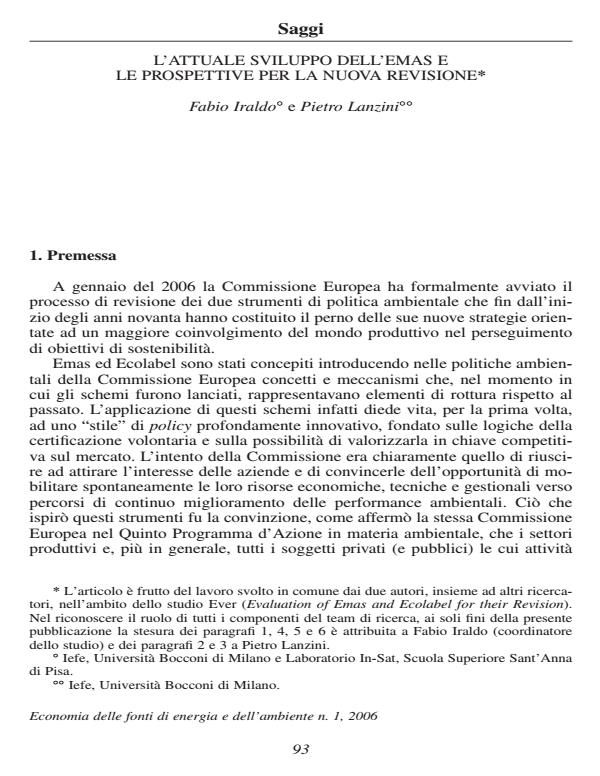L'attuale sviluppo dell'Emas e le prospettive per la nuova revisione
Journal title ECONOMIA DELLE FONTI DI ENERGIA E DELL’AMBIENTE
Author/s Fabio Iraldo, Pietro Lanzini
Publishing Year 2007 Issue 2006/1 Language Italian
Pages 33 P. 93-125 File size 246 KB
DOI
DOI is like a bar code for intellectual property: to have more infomation
click here
Below, you can see the article first page
If you want to buy this article in PDF format, you can do it, following the instructions to buy download credits

FrancoAngeli is member of Publishers International Linking Association, Inc (PILA), a not-for-profit association which run the CrossRef service enabling links to and from online scholarly content.
In sight of the incoming revision process relating to the two most important voluntary instruments of the European Commission, the Ever study has been carried out on behalf of DG Environment, by a consortium of consultants led by Iefe Università Bocconi. The other partners in the consortium were Adelphi Consult, IOEW Office Heidelberg, SPRU Sussex University and Valør & Tinge A/S. The fundamental aim of the Ever study has been to provide recommendations for the revision of these voluntary schemes: Emas and the EU Eco-label. In particolar, the Ever study aimed, on one hand, at delivering a critical appraisal of both the Emas and the Eco-label scheme: the study analysed the relevance (take up and use), the effectiveness (impact on production and consumption patterns) and the efficiency (including cost efficiency) of the two schemes. Furthermore, it identified the drivers and barriers of both voluntary instruments, and investigate their utility (appropriateness as policy instruments) and their viability. On the other hand, the study aimed at providing recommendations by detailing options for improvement: these options shall regard the instruments themselves, linkages between them and linkages to other related initiatives and policies. The options and recommendations proposed for the schemes are based on the evidence collected in the different phases of the Ever study: the ‘desk research’, consisting of a thorough review of existing literature and previous studies and surveys on the schemes, and the ‘in-field’ research, carried out by way of direct interviews and case studies, provided the background relating to their strengths and weaknesses. This article aims at describing the results of the Ever study, with specific reference to Emas.
Fabio Iraldo, Pietro Lanzini, L'attuale sviluppo dell'Emas e le prospettive per la nuova revisione in "ECONOMIA DELLE FONTI DI ENERGIA E DELL’AMBIENTE" 1/2006, pp 93-125, DOI: